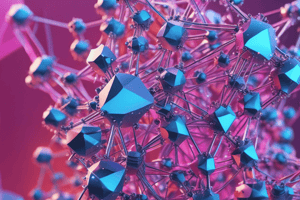Podcast
Questions and Answers
Which crystal system features parallelogram angles?
Which crystal system features parallelogram angles?
- Monoclinic (correct)
- Tetragonal
- Cubic
- Hexagonal
In which crystal system are atoms arranged at the corners of a cube, with eight atoms in total?
In which crystal system are atoms arranged at the corners of a cube, with eight atoms in total?
- Hexagonal
- Tetragonal
- Rhombohedral
- Cubic (correct)
Which crystal system resembles a rectangular prism?
Which crystal system resembles a rectangular prism?
- Tetragonal (correct)
- Hexagonal
- Cubic
- Triclinic
How many atoms are arranged on the surface in the hexagonal crystal system?
How many atoms are arranged on the surface in the hexagonal crystal system?
Which crystal system has additional unit cells and complex arrangements?
Which crystal system has additional unit cells and complex arrangements?
Which software is used for creating 3D models of crystal structures in the lab?
Which software is used for creating 3D models of crystal structures in the lab?
What is the smallest unit cell in the given array of atoms?
What is the smallest unit cell in the given array of atoms?
How are tetrahedral and octahedral holes formed inside a cubic system?
How are tetrahedral and octahedral holes formed inside a cubic system?
What is the structure formed by stacking layers of atoms (A, B, and C) on top of each other?
What is the structure formed by stacking layers of atoms (A, B, and C) on top of each other?
In which compound can smaller ions occupy octahedral and tetrahedral interstitial sites?
In which compound can smaller ions occupy octahedral and tetrahedral interstitial sites?
Flashcards
Crystal Structure
Crystal Structure
A three-dimensional arrangement of atoms in a solid material, forming a repeating pattern in all directions.
Unit Cell
Unit Cell
The smallest repeating unit of a crystal structure.
Cubic System
Cubic System
A crystal system where atoms are arranged at the corners of a cube.
Body Centered Cubic (BCC)
Body Centered Cubic (BCC)
Signup and view all the flashcards
Face Centered Cubic (FCC)
Face Centered Cubic (FCC)
Signup and view all the flashcards
Close Packing
Close Packing
Signup and view all the flashcards
Tetrahedral Hole
Tetrahedral Hole
Signup and view all the flashcards
Octahedral Hole
Octahedral Hole
Signup and view all the flashcards
Ion Arrangement
Ion Arrangement
Signup and view all the flashcards
Cation to Anion Ratio
Cation to Anion Ratio
Signup and view all the flashcards
Study Notes
- Dr. Kja Aisha Bob is conducting an experiment about the arrangements of atoms in solids in EB55 Engineering Materials Introductory Laboratory.
- The lab focuses on the arrangements of atoms in solid materials, specifically discussing the various crystal structures and their properties.
- The arrangements of atoms in solids are important to understand as they affect the properties of the material.
- Atoms in solids are not random, but rather follow specific arrangements classified by Bravais Lattices into 14 categories.
- The simplest crystal system is cubic, where atoms are arranged at the corners of a cube, with eight atoms in total.
- Within the cubic system, there are variations including simple cubic, body center cubic, and face center cubic, each having different arrangements of atoms.
- The tetragonal system has a different unit cell shape, resembling a rectangular prism, and has simple and body centered variations.
- The rhombohedral system features parallelogram angles and is different from cubic and tetragonal systems.
- The hexagonal system has a unique arrangement with six atoms on the surface, three in the middle, and seven more on the base, with two types of unit cells.
- The monoclinic, triclinic, and orthorhombic systems have more complex arrangements and additional unit cells.
- The lab involves creating 3D models of crystal structures using software like Crystal Maker for better visualization.
- The experiment covers simple cubic, body center cubic, and face center cubic arrangements, using polytyrene balls to build models.
- The materials and procedures for building crystal structures are provided in the experiment.- Two-dimensional crystal consists of atoms arranged in a single plane.
- Identify smallest unit cells (unit cells) in the given array of atoms.
- Closest packing structure: build a model using 19 white balls surrounded by plastic stripes.
- Arrange balls in a hexagonal shape with three balls at the sides.
- Inside the arrangement, triangular voids exist, with one pointing down and another pointing up.
- Label voids as D (pointing down) and U (pointing up).
- Three atoms are placed above the voids, creating tetrahedral holes within the structure.
- Octahedral holes are formed by six atoms, with eight surfaces (four at the top and another four at the bottom).
- Inside a cubic system, there are two types of holes: tetrahedral and octahedral.
- Face Center Cubic (FCC) structure can be formed by stacking layers of atoms (A, B, and C) on top of each other.
- Hexagonal Close Pack (HCP) structure is formed by stacking layers of atoms (A, B, and A) on top of each other, alternating between layers.
- Ion Arrangements in Solid: when dealing with multiple elements or ions.
- Octahedra and tetrahedral interstitial sites: smaller ions can occupy them.
- Identify interstitial sites using a table (p. 2.1) by comparing ion radii.
- Cat ion to N ion ratio: 1 to 1 (cubic), 1 to 2 (fluorite structure), or unknown (cubic, octahedral, or tetragonal).
- Determine interstitial sites and ion arrangements for given compounds (Toriun Oxide, Calcium Fluoride, Magnesium Oxide, and Sodium Chloride).
- Create a table for the results of the calculations.
- Ionic radii are provided in Pomer-Pingree units (PM).
Studying That Suits You
Use AI to generate personalized quizzes and flashcards to suit your learning preferences.




